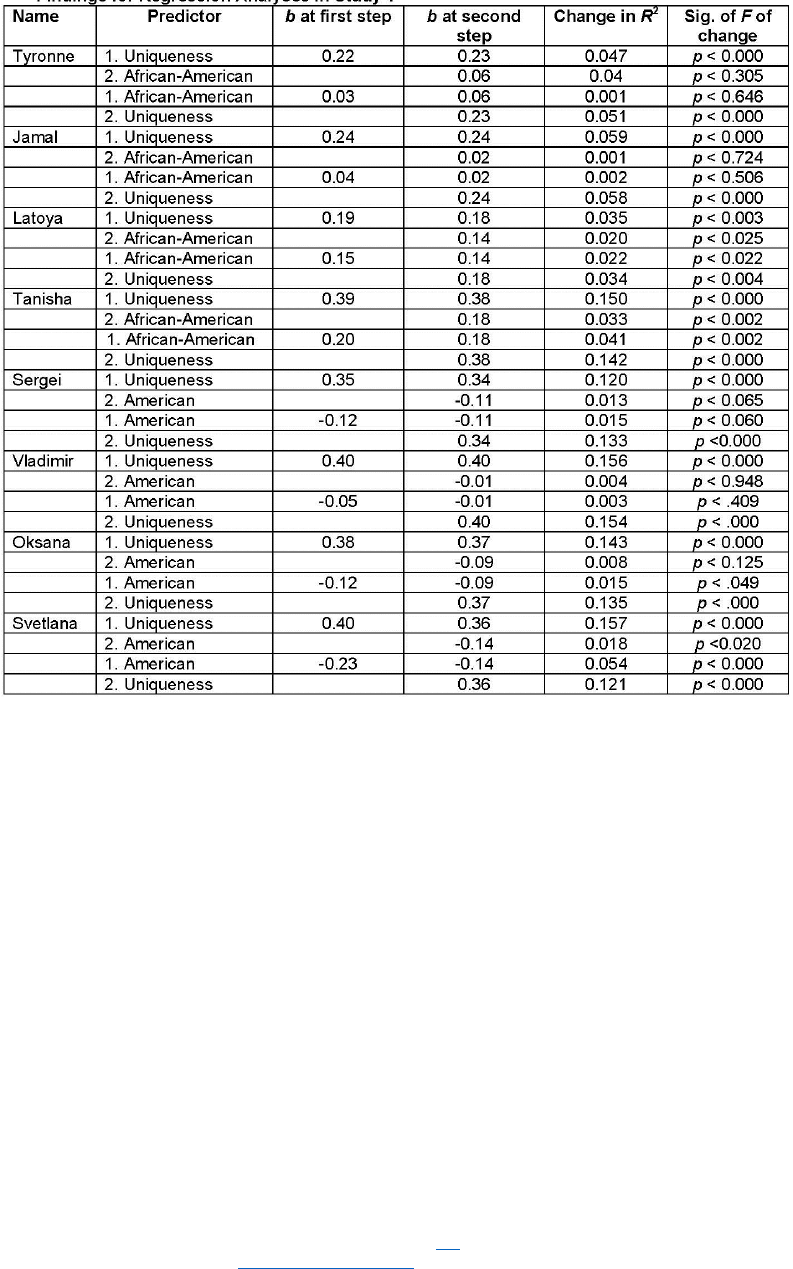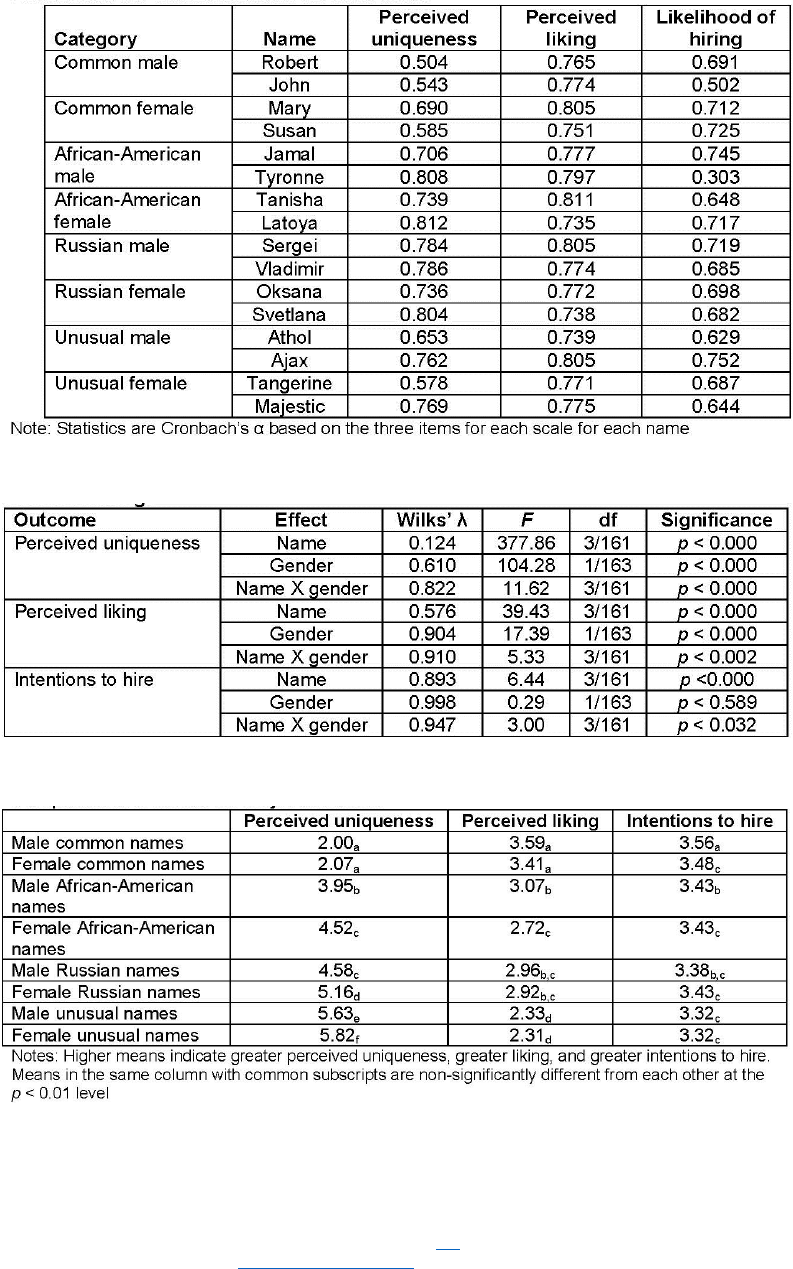
Marquette University Marquette University
e-Publications@Marquette e-Publications@Marquette
Management Faculty Research and
Publications
Management, Department of
2008
The “Name Game”: Affective and Hiring Reactions to First Names The “Name Game”: Affective and Hiring Reactions to First Names
John Cotton
Marquette University
Bonnie S. O'Neill
Marquette University
Andrea Gri<n
Marquette University
Follow this and additional works at: https://epublications.marquette.edu/mgmt_fac
Part of the Business Commons
Recommended Citation Recommended Citation
Cotton, John; O'Neill, Bonnie S.; and Gri<n, Andrea, "The “Name Game”: Affective and Hiring Reactions to
First Names" (2008).
Management Faculty Research and Publications
. 3.
https://epublications.marquette.edu/mgmt_fac/3

NOT THE PUBLISHED VERSION; this is the author’s final, peer-reviewed manuscript. The published version may be
accessed by following the link in the citation at the bottom of the page.
Journal of Managerial Psychology, Vol. 23, No. 1 (2008): pg. 18-39. DOI. This article is © Emerald and permission has been
granted for this version to appear in e-Publications@Marquette. Emerald does not grant permission for this article to be
further copied/distributed or hosted elsewhere without the express permission from Emerald.
1
The “Name Game”: Affective and
Hiring Reactions to First Names
John L. Cotton
Department of Management, Marquette University
Milwaukee, WI
Bonnie S. O’Neill
Department of Management, Marquette University
Milwaukee, WI
Andrea Griffin
Department of Management, Marquette University
Milwaukee, WI
Abstract:
Purpose: The paper seeks to examine how the uniqueness and ethnicity of
first names influence affective reactions to those names and their potential for
hire.
Design/methodology/approach: In study 1, respondents evaluated 48
names in terms of uniqueness and likeability, allowing us to select names
viewed consistently as Common, Russian, African‐American, and Unusual. In
Study 2 respondents assessed the uniqueness and likeability of the names,
and whether they would hire someone with the name.
Findings: Results indicated that Common names were seen as least unique,
best liked, and most likely to be hired. Unusual names were seen as most
unique, least liked, and least likely to be hired. Russian and African‐American
names were intermediate in terms of uniqueness, likeability and being hired,
significantly different from Common and Unique names, but not significantly
different from each other.
Research limitations/implications: The name an individual carries has a
significant impact on how he or she is viewed, and conceivably, whether or
not the individual is hired for a job.

NOT THE PUBLISHED VERSION; this is the author’s final, peer-reviewed manuscript. The published version may be
accessed by following the link in the citation at the bottom of the page.
Journal of Managerial Psychology, Vol. 23, No. 1 (2008): pg. 18-39. DOI. This article is © Emerald and permission has been
granted for this version to appear in e-Publications@Marquette. Emerald does not grant permission for this article to be
further copied/distributed or hosted elsewhere without the express permission from Emerald.
2
Practical implications: Human resource professionals need to be aware that
there seems to be a clear bias in how people perceive names. When resumés
are screened for hiring, names should be left off. Our findings also suggest
that when selecting, parents may want to reconsider choosing something
distinctive.
Originality/value: This study offers original findings in regards to names,
combining diverse research from social psychology and labor economics, and
offering practical implications.
Keywords: Recruitment, Affective psychology, Ethnic groups, Discrimination
Despite laws (e.g. the 1964 Civil Rights Act) and a growing
social/cultural inclination towards fairness, discrimination in hiring
continues (Darity and Mason, 1998). For example, a recent study
found that a Caucasian applicant with a conviction for selling drugs
was more likely to be called back after a job interview than an African‐
American with no record (Pager, 2003). Like most research on hiring
discrimination, that study examined the interview process, where
interviewers are obviously aware of the race or possible ethnic origin
of the applicant (e.g. Sacco et al., 2003). However, most applicants for
a job do not make it to an interview. They are excluded through
information found in a cover letter, an application or a resumé. It is
possible for cover letters and such to influence recruiters, for example,
through ingratiation (Varma et al., 2006). However, if race or ethnic
origin is not specified, it is assumed that this process is race‐neutral.
Yet, there can be many clues signaling race or ethnicity, one of the
primary ones being the applicant's name. Some names imply that the
individual is African‐American (Jamal and Lakisha), while others sound
Caucasian (Greg and Emily) (Bertrand and Mullainathan, 2003). How
are these names perceived by people who make hiring decisions? This
is the focus of our research.
Literature review
Extensive research in social psychology has demonstrated that
when we perceive others as being similar to ourselves, we are
attracted to them (Byrne, 1969). Much of this research has
concentrated on how similar attitudes lead to greater attraction, and
dissimilar attitudes lead to less attraction. We tend to like that which is
familiar and similar to us. Additional research has shown that we are
also attracted to people with similar values (Turban and Jones, 1988),
personalities (DiMarco, 1974), and demographic backgrounds (Glaman

NOT THE PUBLISHED VERSION; this is the author’s final, peer-reviewed manuscript. The published version may be
accessed by following the link in the citation at the bottom of the page.
Journal of Managerial Psychology, Vol. 23, No. 1 (2008): pg. 18-39. DOI. This article is © Emerald and permission has been
granted for this version to appear in e-Publications@Marquette. Emerald does not grant permission for this article to be
further copied/distributed or hosted elsewhere without the express permission from Emerald.
3
et al., 1996). This research has examined similarity in work groups,
between superiors and subordinates, and between interviewers and
applicants. However, as we noted above, perceptions of similarity or
dissimilarity can be made before meeting a person, perhaps based on
a person's name. A common or familiar first name will be perceived as
similar, while an unusual name will appear dissimilar. How does the
uniqueness of various types of first names influence affective reactions
to those names?
Our research integrates earlier research from two academic
areas that have examined first names. First, there is considerable
research in social psychology on how an individual's name elicits
impressions about the individual, even prior to interaction. Mehrabian
(1990, 2001) and others in social psychology have examined how a
variety of factors influence the perceptions of people with certain
names. Studies have found, for example, that unique names (unusual
names or unusual spellings) connote less attractive characteristics
than names that are more common (Mehrabian, 2001), and were seen
as less desirable (Busse and Seraydarian, 1978; Mehrabian, 1992).
Most of these studies examine people's evaluative reactions to people
with these names, asking respondents to evaluate across various
dimensions (e.g. ethical, successful, fun, masculinity). Only one study
examined decisions made about people with different names. Garwood
et al. (1980) found that desirable names led to more votes in selecting
a beauty queen.
Other name attributes have also been studied. Nicknames have
been found to imply less successful characteristics (Mehrabian and
Piercy, 1993a). With male names, longer names connoted more ethical
caring, and more success (Mehrabian and Piercy, 1993b). Leirer et al.
(1982) found that formal versions of a name (e.g. Robert versus Bob
or Bobby) elicit different inferences concerning personality. Joubert
(1994) found that rare names were rated as lower in class status than
more common names. Dinur et al. (1996) found that Israeli student
preferences for names corresponded with their stereotypes about the
names.
In summary, first names lead to a variety of implied
characteristics. The most consistent findings were that more unique
names are seen as less desirable and tend to elicit more unfavorable

NOT THE PUBLISHED VERSION; this is the author’s final, peer-reviewed manuscript. The published version may be
accessed by following the link in the citation at the bottom of the page.
Journal of Managerial Psychology, Vol. 23, No. 1 (2008): pg. 18-39. DOI. This article is © Emerald and permission has been
granted for this version to appear in e-Publications@Marquette. Emerald does not grant permission for this article to be
further copied/distributed or hosted elsewhere without the express permission from Emerald.
4
characteristics. The research did not directly examine racial and ethnic
differences, nor (with one exception) did it investigate decisions based
on the names.
The second area of research comes from labor economics, and
examines how African‐American names may influence hiring decisions
and life outcomes. Fryer and Levitt (2004) describe how the names
chosen by African‐American parents have shifted over time. Prior to
the 1970s, African‐Americans tended to choose common names for
their children. Beginning in the 1970s, however, to be distinct or
unique, African‐American parents increasingly chose African sounding
names, and this pattern continues today. The names tend to
incorporate elements of both African and American culture (Lieberson
and Mikelson, 1995)[1]. Fryer and Levitt's (2004) data indicates that
not only are these names distinctively African‐American, but that
among those born in the last two decades, “a distinctly Black name is
now a much stronger predictor of socioeconomic status” (p. 801). This
study found that African‐sounding names tend to be more common
among lower‐class African‐Americans. So names can imply not only
race, but also economic class. However, in looking at life outcomes,
Fryer and Levitt (2004) found that distinctly African‐American names
are unrelated to the life outcomes, after including controls for
education, education of parents, age of mother, marital status of
mother, and other factors. They suggest, however, that names may be
correlated with other determinants of productivity that are not
typically captured by the information provided in a resumé.
Employing an experimental design, Bertrand and Mullainathan
(2003) examined how names influence callbacks for job interviews.
These authors sent out resumés with a variety of African‐American and
Caucasian‐sounding names. Their results indicated that resumés with
African‐sounding names received fewer callbacks than the Caucasian
names. In addition, a higher‐quality resumé elicited more callbacks
with Caucasian names, but the greater quality had no impact on
callbacks when paired with an African‐American name. This research
was repeated and publicized in a 20/20 segment on ABC, where they
posted 22 pairs of names with identical resumés on prominent job
websites and found that Caucasian names received more attention
than African‐American sounding names (Ruppel, 2004).

NOT THE PUBLISHED VERSION; this is the author’s final, peer-reviewed manuscript. The published version may be
accessed by following the link in the citation at the bottom of the page.
Journal of Managerial Psychology, Vol. 23, No. 1 (2008): pg. 18-39. DOI. This article is © Emerald and permission has been
granted for this version to appear in e-Publications@Marquette. Emerald does not grant permission for this article to be
further copied/distributed or hosted elsewhere without the express permission from Emerald.
5
Related to the research in labor economics, Bart et al. (1997)
examined how the gender and race of respondents can influence
reactions to different names on resumés. Employing a sample of
college undergraduates, they asked respondents to read a resumé with
either a Caucasian‐sounding female name (Mary Ann Roberts) or an
African‐American female name (Lakesia Washington). Consistent with
the similarity‐attraction literature (Byrne, 1969; Goldberg, 2005), the
authors found that female raters evaluated the female candidates
higher than male raters, and that African‐American raters evaluated
the African‐American candidates higher than the Caucasian raters
(Bart et al., 1997, p. 302). In addition, female raters had lower pay
expectations than male raters, and African‐American female raters had
the lowest pay expectations of all.
The research above has answered a number of interesting
questions. However, there are still major concerns and gaps in current
knowledge in this area. The research from social psychology has
examined a variety of name characteristics, but the dependent
variables are often global assessments on general dimensions (good‐
bad, active‐passive, strong‐weak, successfulness, ethical, etc.). It is
difficult to say how these characteristics influence actual behavior, for
example, hiring decisions. In addition, this research has not compared
racial and ethnic names. Bertrand and Mullainathan's (2003) study
from labor economics examined job‐hiring behavior, but it was not
clear whether the effects were entirely due to race. For example, some
of the Caucasian names used were Emily, Allison, Kristen, Brendan,
Geoffrey, and Brett. Many of these names are not only Caucasian, they
also tend to be perceived as above average in success (Mehrabian,
1990). It is possible that the names employed varied not just on race,
but also on perceptions of familiarity, socioeconomic status, or other
characteristics (Fryer and Levitt, 2004). For example, the African‐
American names (Latoya, Ebony, and Tremayne) are more unique
than the Caucasian names (Jill, Anne, Greg). In addition to race, a lack
of familiarity towards certain names may influence reactions. These
additional explanations for the effects attributed to race may also
apply to the findings of Bart et al. (1997).

NOT THE PUBLISHED VERSION; this is the author’s final, peer-reviewed manuscript. The published version may be
accessed by following the link in the citation at the bottom of the page.
Journal of Managerial Psychology, Vol. 23, No. 1 (2008): pg. 18-39. DOI. This article is © Emerald and permission has been
granted for this version to appear in e-Publications@Marquette. Emerald does not grant permission for this article to be
further copied/distributed or hosted elsewhere without the express permission from Emerald.
6
Research issues
Although prior research hints at the impact that the uniqueness
of African‐American names can have on various outcomes, no research
to date has examined the influence of uniqueness on individuals'
perceptions of African‐American and other ethnic names and their
potential for hire. In this paper we expand on prior work by examining
whether individuals with unique or ethnic names are perceived the
same way as those with African‐American names.
Based on the research reviewed above, we argue that as names
vary in how unique they are perceived, so will they vary in how well
they are liked. Therefore we make the following hypotheses:
H1. Common names will be seen as familiar by individuals, and
more unique names will be seen as less familiar.
H2. Common names will be liked the most and names which are
the most unique will be liked the least.
H3. African‐American and other ethnic names will be seen as
more unique than common names, and will therefore be liked
less than common names.
Two studies were conducted to test the hypotheses above. The
first study examined responses to a wide variety of names in order to
determine if individuals perceived differences in uniqueness between
the names and if uniqueness was related to likeability. The second
study was designed to focus more closely on a selected subset of
names. In addition to examining the uniqueness of names on
likeability, the second study also examined how uniqueness influenced
hiring intentions.
Study 1
Sample and procedure
In the first study we examined the perceptions of working adults
and undergraduate business students to various names. Similar to
past research, we prepared collections of Common names (i.e.
categorized as White names in prior studies) and African‐American
names. We expanded our name categories to include Russian names,

NOT THE PUBLISHED VERSION; this is the author’s final, peer-reviewed manuscript. The published version may be
accessed by following the link in the citation at the bottom of the page.
Journal of Managerial Psychology, Vol. 23, No. 1 (2008): pg. 18-39. DOI. This article is © Emerald and permission has been
granted for this version to appear in e-Publications@Marquette. Emerald does not grant permission for this article to be
further copied/distributed or hosted elsewhere without the express permission from Emerald.
7
which would be racially classified as White, but like the African‐
American names would be perceived as more unique (and less similar)
than the Common names. In this way we could differentiate between
race and uniqueness in our comparisons across name categories. We
also included a group of unique names, which we labeled Unusual. For
Common names, we accessed the Social Security Administration
website (www.ssa.gov/OACT/babynames/), which identified the most
common male and female baby names in the USA for the past three
decades. We selected male and female names that consistently ranked
as the most popular names, as these names would be most likely to be
perceived as similar by respondents[2].
Since the SSA website did not provide a list of names by race or
ethnicity, we conducted an internet search on a variety of websites
that provided names for each of the remaining categories. African‐
American and Russian names were chosen based on those names we
found most often and we also included several names examined in
prior studies. Unusual names were chosen based on those names
thought by the researchers to be fictitious and/or unheard of in
mainstream American culture (i.e. not used by any popular/media
person).
A total of 48 names (six male and six female from each of the
four categories) were employed in this study. These names were given
to 505 individuals enrolled in business programs at a university located
in the upper Midwest. Of these individuals, 153 were working adults
(employed full‐time and participating in a part‐time graduate business
program) and 352 were full‐time undergraduate business students
(either not working or working part‐time). Fifty‐five percent of the
sample was male and 45 percent was female. In terms of
demographics, 81 percent of the sample were Caucasian, 4 percent
were African‐American, 4 percent were Hispanic, and 6 percent
identified themselves as Asian. Students did not receive extra credit
for participation, but were simply asked to volunteer their time. The
vast majority of students (approximately 95 percent) responded. To
avoid exhaustion (and incomplete responses), half of the names were
given to about half the respondents, and the other half of the names
were given to the rest of the respondents. Using a Likert scale ranging
from 1 (strongly disagree) to 7 (strongly agree), the respondents were
asked to evaluate names across a variety of dimensions, including

NOT THE PUBLISHED VERSION; this is the author’s final, peer-reviewed manuscript. The published version may be
accessed by following the link in the citation at the bottom of the page.
Journal of Managerial Psychology, Vol. 23, No. 1 (2008): pg. 18-39. DOI. This article is © Emerald and permission has been
granted for this version to appear in e-Publications@Marquette. Emerald does not grant permission for this article to be
further copied/distributed or hosted elsewhere without the express permission from Emerald.
8
uniqueness, likeability, nationality, ethnicity, and gender. All questions
used are listed in Table I.
Results
One purpose of Study 1 was to select names that are
consistently viewed as Common, African‐American, Russian, and
Unusual. On a scale from 1 to 7, the following names were rated at 1.5
or below as being “different”: John, Robert, Mary, and Susan. The
following names were rated at or above 6.0 as expected to be African‐
American: Tyronne, Jamal, Latoya, and Tanisha. The following names
were rated below 3.0 as expected to be American (i.e. were not seen
as American): Vladamir, Sergei, Oksana, Svetlana. Finally, the
following names were rated at or above 6.0 as being “different”: Ajax,
Atholl, Magestic, and Tangerine. In addition to confirming our
expectations regarding perceived nationality and ethnicity, the
respondents viewed the names as being male or female, although
these findings were not as consistent for the Unusual names as they
were for the other categories.
A second purpose of Study 1 was to see how the various names
were viewed in terms of how unique and how likeable they were
perceived to be. We attempted to combine several of the questionnaire
items into scales; however, the reliabilities were so low that we had to
examine the questions individually. When comparing the 16 names
chosen above, we found a consistent, often statistically significant
pattern, although this was not true for every question with every
name. Table I shows the means for all of the questions across the 16
names selected.
As expected, Common names were seen as less “different” than
other names, followed by the African‐American names and Russian
names, followed (distantly) by the Unusual names. These effects also
carried over to the likeability of the names. Common names were seen
as being more likeable or better than the other three groups. Unusual
names were seen as being less likeable or not as good as the other
three groups. African‐American names and Russian names were in the
middle, usually significantly different from Common and Unusual

NOT THE PUBLISHED VERSION; this is the author’s final, peer-reviewed manuscript. The published version may be
accessed by following the link in the citation at the bottom of the page.
Journal of Managerial Psychology, Vol. 23, No. 1 (2008): pg. 18-39. DOI. This article is © Emerald and permission has been
granted for this version to appear in e-Publications@Marquette. Emerald does not grant permission for this article to be
further copied/distributed or hosted elsewhere without the express permission from Emerald.
9
names, but often not different from each other. Similar results were
found for both male and female names.
The means in Table I suggest that uniqueness in names has a
powerful impact on likeability concerning those names. Race and
ethnic origin seem to also have an impact, but it is not clear if these
are due to perceptions of race/ethnicity, or whether the novelty of
these names makes them less likeable. To explore the possible
influence of race and ethnic origin on individuals' perceptions of liking,
post hoc regression analyses were conducted on each of the four
chosen African‐American names (Jamal, Tyronne, Latoya, and Tanisha)
and the four chosen Russian names (Oksana, Svetlana, Vladimir, and
Sergei).
The regressions on African‐American names employed both
uniqueness (“This name seems different”) and perceptions of being
African‐American (“I would expect a person with this name to be an
African American”) as predictors of liking. Two hierarchical regressions
were performed for each name. One regression entered uniqueness
and then being African‐American into the equation; the second
regression entered being African‐American and then entered
uniqueness in the second step. The analyses for the male names found
that perceptions of being unique significantly predicted liking, but
expectations of the person being an African‐American had no effect
(see Table II). This pattern was consistent for both male names,
across all respondents (both working adults and undergraduate
students). The pattern was somewhat different for the female names.
For these names, both the perceptions of being unique and the
expectation of being an African‐American were related to liking. These
results were found for both of the female names, across all
respondents. However, in looking at the change in R
2
, it is clear that
even when both are significant, being unique is a stronger predictor
(average R
2
=0.090) than being African‐American (average R
2
=0.029).
The hierarchical regression analyses above were also performed for
the African‐American names that were not chosen for Study 2, with the
same results.
The regressions on Russian names employed both uniqueness
(This name seems different”) and perceptions of being American (“I
would expect a person with this name to be an American”) as

NOT THE PUBLISHED VERSION; this is the author’s final, peer-reviewed manuscript. The published version may be
accessed by following the link in the citation at the bottom of the page.
Journal of Managerial Psychology, Vol. 23, No. 1 (2008): pg. 18-39. DOI. This article is © Emerald and permission has been
granted for this version to appear in e-Publications@Marquette. Emerald does not grant permission for this article to be
further copied/distributed or hosted elsewhere without the express permission from Emerald.
10
predictors of liking. Two hierarchical regressions were performed for
each name. One regression entered uniqueness and then being
American into the equation; the second regression entered being
American and then entered uniqueness in the second step. The
analyses found that both uniqueness and being an American predicted
liking for one of the four names (Svetlana). For the other three names,
being American was not a significant predictor. Overall, the effect for
uniqueness was very powerful (average change in R
2
=0.15) while the
effect for not being American, even when significant, was much
smaller (average change in R
2
=0.014).
Discussion
The findings above suggest that uniqueness in names can have
a powerful impact on likeability concerning those names. H1 and H2
were clearly supported. H3 was partially supported, in that race and
ethnic origin at times also had an impact. However, these factors
appear to be less powerful than uniqueness, disappearing entirely for
some of the names when controlling for uniqueness.
Although this study examined our hypotheses, there are several
limitations. First, a single survey was used to select names based on
perceptions of race and ethnicity. Then, within the same survey,
respondents evaluated the names in terms of liking. To avoid the
problem of common methods bias, it would be more effective to have
one sample determine the choice of names and a second sample
evaluate the names. Second, not all respondents responded to the
same set of names. However, having all individuals respond to all
names would have been an exhaustive process and we expected that
respondents would have been incapable of accurately completing such
a lengthy survey. We made every attempt to distribute the names
evenly (e.g. equal distributions of Common, Russian, African‐
American, and Unusual names) across the two surveys and two
samples. However, it is possible that the effects noted in our results
may be influenced by comparisons with the other names the
respondents read and evaluated on their particular survey and may
not generalize to other names or respondents. Third, evaluations of
uniqueness and liking were assessed with single items. We had
intended to combine the various questions into scales, but did not find

NOT THE PUBLISHED VERSION; this is the author’s final, peer-reviewed manuscript. The published version may be
accessed by following the link in the citation at the bottom of the page.
Journal of Managerial Psychology, Vol. 23, No. 1 (2008): pg. 18-39. DOI. This article is © Emerald and permission has been
granted for this version to appear in e-Publications@Marquette. Emerald does not grant permission for this article to be
further copied/distributed or hosted elsewhere without the express permission from Emerald.
11
sufficient consistency between the items to develop valid scales.
Finally, we did not assess intended behavior, such as whether a
respondent would want to hire someone with that name. In the next
study, we conduct a replication of Study 1 and extend our analyses to
examine respondents' intentions to hire individuals with these names.
In this study we also controlled for some of the limitations noted in
Study 1, where possible.
Study 2
Sample and procedure
This study utilized the 16 names identified in Study 1 as best
fitting the ethnic, racial and common/unique categories we
established. In order to conduct a replication of our first study, we
asked respondents to evaluate the names in terms of how unique they
were and how much they liked the names. Then, to capture
perceptions related to employment behavior, we asked respondents
several questions related to how willing they would be to hire people
with those names. The respondents were 166 students in a variety of
part‐time graduate business programs in a university located in the
Midwest. The survey asked whether respondents had participated in
the first study, and 4.2 percent (or seven of the respondents) said
they had. This low number of overlapping respondents indicates that
our sample was largely a new sample of working adults. This provided
an opportunity to conduct a replication of perceptions of uniqueness
and liking from Study 1. The mean age among these respondents was
30 years, and they averaged 8.41 years of work experience, providing
a sample that is likely to be representative of working adults in
positions with hiring responsibilities. Of the respondents, 61 percent
were male and 39 percent were female. In terms of race, 78 percent
were Caucasian, while 4 percent were African‐American, 12 percent
were Asian or Pacific Islander, 2 percent were Hispanic, and 3 percent
were “other”. All respondents rated all of the names. Using the results
from the first study, we employed the 16 names that respondents
reliably identified as Common, African‐American, Russian, and
Unusual. Half of the names were female, the other half male. We
therefore have two names for each cell in an eight‐cell format.

NOT THE PUBLISHED VERSION; this is the author’s final, peer-reviewed manuscript. The published version may be
accessed by following the link in the citation at the bottom of the page.
Journal of Managerial Psychology, Vol. 23, No. 1 (2008): pg. 18-39. DOI. This article is © Emerald and permission has been
granted for this version to appear in e-Publications@Marquette. Emerald does not grant permission for this article to be
further copied/distributed or hosted elsewhere without the express permission from Emerald.
12
Measures
The three primary dependent variables were likeability,
uniqueness, and hiring intentions related to the name. Three questions
were employed to measure each variable (see Appendix). The
reliabilities of these scales were assessed for each name. These
reliabilities are presented in Table III.
The reliabilities for the uniqueness scale ranged from 0.50 to
0.81, with the majority between 0.74 and 0.81. For perceived
likeability the reliabilities ranged from 0.74 to 0.81, with the majority
between 0.77 and 0.81. For intentions to hire, the reliabilities ranged
from 0.30 to 0.75, with the majority between 0.69 and 0.75. There
were no detectable patterns between the names with low reliabilities.
Results
The structure of the study can be considered a 4×2 factorial
design, with four levels of name type by gender. The levels of name
type range in sequence from Common names to African‐American, to
Russian, to Unusual names. This approach represents the order of
perceived uniqueness of the names in Study 1. As expected, the
overall analyses indicate that the type of name influenced perceptions
of uniqueness, likeability, and intentions to hire. However, the more
interesting findings are the direct comparisons among the types of
names. Therefore, for each of the dependent measures we performed
an overall MANOVA followed by comparisons across the various types
of names. The overall analyses are 4×2 repeated‐measures MANOVAs
(since all respondents evaluated all of the names). The follow‐up
comparisons are a priorit‐tests, with expected differences between the
four types of names. Because of the large number of t‐tests, we are
employing a significance level of p<0.01.
In terms of perceived uniqueness, the overall MANOVA was
significant for name type (Wilks' λ=0.124, F=377.86, p<0.001), for
gender (Wilks' λ=0.963, F=104.28, p<0.001), and for the name
category by gender interaction (Wilks' λ=822, F=11.62, p<0.01)[3].
The findings for the MANOVAs are presented in Table IV.

NOT THE PUBLISHED VERSION; this is the author’s final, peer-reviewed manuscript. The published version may be
accessed by following the link in the citation at the bottom of the page.
Journal of Managerial Psychology, Vol. 23, No. 1 (2008): pg. 18-39. DOI. This article is © Emerald and permission has been
granted for this version to appear in e-Publications@Marquette. Emerald does not grant permission for this article to be
further copied/distributed or hosted elsewhere without the express permission from Emerald.
13
Because of the gender interaction, separate a priori t‐tests were
conducted for all categories of male and female names. These t‐tests
indicated that perceptions of uniqueness were significantly different
across all name types for the male names (p<0.001), with the
Common names seen as least unique, followed by the African‐
American names, followed by the Russian names, with the Unusual
names perceived as being the most unique. The results were similar
for female names. The only exception to this pattern was that female
African‐American names were not seen as significantly different from
male Russian names. The findings for the t‐tests are presented in
Table V.
The MANOVA for the likeability scale was also significant for
name type (Wilks' λ=0.576, F=39.43, p<0.001), for gender (Wilks'
λ=0.904, F=17.39, p<0.001), and for the name category by gender
interaction (Wilks' λ=0.910, F=5.33, p<0.002). Again, separate t‐tests
were conducted for male and female names. The t‐tests for the male
names indicated that all of the name types were significantly different
from each other (p<0.001) in terms of likeability, with the exception of
the African‐American names and the Russian names. As in Study 1,
the Common names were liked the most, followed by the African‐
American names, followed by the Russian names, with the Unusual
names being the least popular. However, the difference between the
African‐American and Russian names was non‐significant (p<0.11). A
similar pattern was found for the female names. With female names,
the Common names were liked the most, followed by the Russian
names, the African‐American names, and the Unusual names. Like the
male names, the African‐American female names were not significantly
different from the Russian names.
In terms of intentions to hire individuals with the name, the
MANOVA was significant for name type (Wilks' λ=0.893, F=6.44,
p<0.001), but not for gender (Wilks' λ=0.998, F=0.293, p<0.60), and
was marginally significant for the name by gender interaction (Wilks'
λ=0.947, F=3.00, p<0.05). As predicted, respondents were most
likely to hire someone with a Common name, followed someone with
an African‐American name, a Russian name, and least likely to hire
someone with an Unusual name. Differences between the Common
male names and the other male names were significant (p<0.001).
The Unusual names were significantly different from the Common

NOT THE PUBLISHED VERSION; this is the author’s final, peer-reviewed manuscript. The published version may be
accessed by following the link in the citation at the bottom of the page.
Journal of Managerial Psychology, Vol. 23, No. 1 (2008): pg. 18-39. DOI. This article is © Emerald and permission has been
granted for this version to appear in e-Publications@Marquette. Emerald does not grant permission for this article to be
further copied/distributed or hosted elsewhere without the express permission from Emerald.
14
names and the African‐American names, but not the Russian names
(p<0.02). The African‐American and Russian names were non‐
significantly different from each other. With the female names, there
were no significant differences at the p<0.001 level. However, if a less
conservative significance level was used (e.g. p<0.02), the Unusual
names would have been significantly different from the other three
groups. The Common, African‐American, and Russian names were non‐
significantly different from each other.
We also conducted additional MANOVA analyses to see if
characteristics of the respondents influenced their reactions to names.
No significant effects or interactions were found for the gender of the
respondents. In terms of race, Caucasian respondents (n=131) were
compared with all other groups (n=34)[4]. This analysis also found no
effects. Finally, the respondents were divided into three groups on the
basis of work experience. These groups consisted of those respondents
with zero to four years of experience (n=56), five to ten years of
experience (n=55), and those with more than ten years of experience
(n=49). Like the other respondent characteristics, no effects were
found for respondents' work experience.
Discussion
The two studies here demonstrate that “a rose by any other
name” is not appreciated the same way. Our results from both studies
indicate that the name that an individual carries has a significant
impact on how he or she is viewed, and conceivably, whether or not
the individual is hired for a job. Names that were seen as being more
unique were liked less, and in the second study, were less likely to be
hired. The best names (most liked and rated most likely to be hired)
were the most common ones (e.g. Mary, Robert), while the worst
names (least liked and least likely to be hired) were the most unusual
(e.g. Atholl, Magestic). In between these extremes were African‐
American and Russian names. These names were seen as being
intermediate in terms of being unique, and were also intermediate in
terms of how much they were liked and how likely they were to be
hired.

NOT THE PUBLISHED VERSION; this is the author’s final, peer-reviewed manuscript. The published version may be
accessed by following the link in the citation at the bottom of the page.
Journal of Managerial Psychology, Vol. 23, No. 1 (2008): pg. 18-39. DOI. This article is © Emerald and permission has been
granted for this version to appear in e-Publications@Marquette. Emerald does not grant permission for this article to be
further copied/distributed or hosted elsewhere without the express permission from Emerald.
15
In spite of the effects above, Study 2 simply asked respondents
how likely they would hire a person with a specific name. It is a
considerable leap from there to conclude that this would actually lead
to differential hiring behavior. Therefore, our next step was to examine
this hiring behavior in a controlled, laboratory setting. In Study 3,
described below, respondents were given resumés containing the
various names, and then asked how likely they would be to hire this
person.
Study 3
Sample
The respondents for this study were 105 working adults enrolled
in a part‐time MBA program who had not participated in either of the
earlier studies. The students varied in age from 21 to 47, with a mode
of 26 and a mean of 28. They averaged 6.25 years of work experience,
and 55 percent reported that they had been involved in hiring at some
point. Of the sample, 62 percent were male and 31 percent were
female, with 7 percent not reporting gender. In addition, 82 percent
were Caucasian, with 2 percent African‐American, 4 percent Asian or
Pacific Islander, 3 percent Hispanic, and 2 percent “other”. A total of 7
percent of the sample did not indicate their race.
Procedure
The students were asked at the beginning of a class if they were
willing to participate in a study examining hiring decisions. Students
did not receive extra credit for participation, but were simply asked to
volunteer their time. Virtually all (more than 95 percent) students
participated. Respondents were told that they should imagine
themselves hiring a new administrative assistant for PMA Consultants
LLC, an actual company located in Chicago. The instructions included
an actual ad for an administrative assistant taken from the Chicago
Tribune. Respondents were given a booklet with eight resumés and
eight sets of questions regarding hiring. Each of the resumés was
constructed to provide a reasonable candidate for the position.
Pretesting of the resumés had been conducted with graduate students
enrolled in a staffing class in order to assess comparability of the

NOT THE PUBLISHED VERSION; this is the author’s final, peer-reviewed manuscript. The published version may be
accessed by following the link in the citation at the bottom of the page.
Journal of Managerial Psychology, Vol. 23, No. 1 (2008): pg. 18-39. DOI. This article is © Emerald and permission has been
granted for this version to appear in e-Publications@Marquette. Emerald does not grant permission for this article to be
further copied/distributed or hosted elsewhere without the express permission from Emerald.
16
resumés in terms of education and experience. Slight modifications
were made to certain resumés, as recommended. The resumés used
the same names employed in Study 2, with one male and female
name from each of the four name categories. The names, resumés and
their order were randomly assigned to each booklet. After each
resumé, six questions were listed for respondents to evaluate on a
seven‐point Likert scale (1=strongly disagree to 7=strongly agree)
how likely they would be to hire the candidate (e.g. “Given what I
know, I would hire this person for the position”). At the end of the
booklet were several demographic questions.
Results
Reliability analyses demonstrated that the six evaluation
questions were highly interrelated. The reliability of the scales
(Cronbach's α) varied from a low of 0.914 (White female resumés) to a
high of 0.938 (unusual female resumé). Like Study 2, the responses
were examined in an overall MANOVA followed by comparisons across
the various types of names. The overall analyses are 4×2 (name
category by gender) repeated‐measures MANOVAs and the follow‐up
comparisons are a priorit‐tests, with expected differences between the
four types of names.
The overall MANOVA was not significant for name type (Wilks'
λ=0.944, F=1.998, p<0.12), for gender (Wilks' λ=0.995, F=0.572,
p<0.50), nor for the name category by gender interaction (Wilks'
λ=0.947, F=0.894, p<0.50). Given the lack of overall effects, it was
not surprising that none of the t‐tests were significant at the 0.01 level
(largest t=2.02). Additional analyses were performed to see if
demographic characteristics of the respondents (sex, race, work
experience, hiring experience) influenced their reactions to names.
Very few significant interactions were found for these analyses (three
of 48 effects were significant at p<0.05).
Discussion
Given the strong findings from Study 1 and Study 2, the total
lack of effects in Study 3 was surprising. There are several possible
explanations. One possibility is that names influence affective

NOT THE PUBLISHED VERSION; this is the author’s final, peer-reviewed manuscript. The published version may be
accessed by following the link in the citation at the bottom of the page.
Journal of Managerial Psychology, Vol. 23, No. 1 (2008): pg. 18-39. DOI. This article is © Emerald and permission has been
granted for this version to appear in e-Publications@Marquette. Emerald does not grant permission for this article to be
further copied/distributed or hosted elsewhere without the express permission from Emerald.
17
reactions but not behavior. In other words, people may not like certain
types of names, but these feelings do not influence hiring. However,
field research from Bertrand and Mullainathan (2003) and Bart et al.
(1997) suggests that there should be effects for names that indicate
race or gender. A second possible explanation is that our hiring
simulation did not completely imitate what happens in an actual
business context. Instead of seeing the task as a part of everyday
work, the respondents may have perceived it as some type of
academic test or problem, and worked hard studying the resumés to
make their decision. Since respondents were employed full‐time, many
in managerial positions, they may have been exhibiting an acquisitive
orientation of impression management. This occurs among managers
when they are concerned about obtaining approval from their audience
(Palmer et al., 2001). In the present context, students knew that
individuals administering the survey were colleagues of their course
instructors and they may have been attempting to positively influence
their instructors' initial impressions of them. This explanation is
consistent with some of our experiences in administering the survey.
First, respondents were given the opportunity to write written
comments after evaluating each candidate. Over 76 percent of the
respondents provided open‐ended comments, and many respondents
wrote comments about every candidate. Second, it took most
respondents about 15 minutes, and some as long as 20 minutes, to
evaluate eight single‐page resumés. It is unlikely that a typical hiring
manager spends that much time and effort in a preliminary review of
resumés for non‐exempt positions. Written comments by respondents
in Study 3 suggested a strong focus on the schooling and prior work
experiences of applicants, despite it being an administrative assistant
position (i.e. the position did not require advanced education or
extensive work experience).
This brings up an interesting question: at what point in the
hiring process does an applicant's name influence the hiring manager?
When quickly sorting through a large stack of applicant resumés,
managers frequently scan for key words before reading in more depth
(Capelli, 2001). However, in our laboratory test, the respondents
carefully went through all of the information before making any
evaluations, much like managers do after completing the preliminary
screening process. This may have resulted in the names having no real

NOT THE PUBLISHED VERSION; this is the author’s final, peer-reviewed manuscript. The published version may be
accessed by following the link in the citation at the bottom of the page.
Journal of Managerial Psychology, Vol. 23, No. 1 (2008): pg. 18-39. DOI. This article is © Emerald and permission has been
granted for this version to appear in e-Publications@Marquette. Emerald does not grant permission for this article to be
further copied/distributed or hosted elsewhere without the express permission from Emerald.
18
impact. In practice, however, managers first do a superficial sorting of
resumés, and first impressions may be based on similarity to oneself
early in the screening process.
In essence, it may be that our laboratory task does not reflect
the actual process managers follow when hiring. In most contemporary
workplaces, managers must balance the costs associated with
spending their valuable time against the anticipated value of a good
hire. Instead of reading every applicant's materials in depth, a hiring
manager scans the resumé for specific skills or experience, sorting the
resumés accordingly. We investigated this possibility by asking several
HR managers about the process they typically use in hiring for similar
non‐exempt positions. Without exception, every manager responded
that they always skim the resumés they are evaluating first, allocating
much more time only to a small subset of qualified applicants. As one
respondent explained, “Typically, I only look at education/degree,
company name and dates and titles”. Another respondent commented,
“I probably spend about 5 seconds per resumé in the initial skimming
process”. Another estimated that about 30 seconds was spent per
resumé. One piece of information in this brief analysis would be the
person's name, which could have a significant impact.
Sociology research examining homophily – the theory that
contact between similar people is considerably greater than with
dissimilar people – finds that individuals often negatively discriminate
when they know little about a person other than their education,
occupation or similar characteristics (see McPherson et al., 2001). In
addition, inter‐group contact theory implies that as inter‐group contact
increases (in this case, racial and ethnic inter‐group contact exposure),
inter‐group prejudice decreases (thereby reducing the likelihood of
active discrimination (Pettigrew and Tropp, 2006). And, Christopher
(1998) suggests that “although a person's first name does make a
difference in how he or she is perceived by others, the impact of a
name diminishes when additional information about the person is
available” (p. 1180).
These arguments suggest that if a name were to influence a
hiring manager, it would probably occur early in the hiring process,
when little is known about the applicant beyond his or her name and
when little time is spent carefully reviewing the resumé.

NOT THE PUBLISHED VERSION; this is the author’s final, peer-reviewed manuscript. The published version may be
accessed by following the link in the citation at the bottom of the page.
Journal of Managerial Psychology, Vol. 23, No. 1 (2008): pg. 18-39. DOI. This article is © Emerald and permission has been
granted for this version to appear in e-Publications@Marquette. Emerald does not grant permission for this article to be
further copied/distributed or hosted elsewhere without the express permission from Emerald.
19
Overall discussion
The results from these three studies complement and expand on
the findings from research in social psychology. We have taken the
results from those studies and applied them to personnel decisions.
Our results also complement and expand on the findings from labor
economics, principally the findings from Bertrand and Mullainathan
(2003) and Bart et al. (1997). However, our findings suggest that their
results may not have been due simply to racial prejudice. We found
similar effects for both African‐American and Russian names. We found
prejudice for a variety of unique names, not just African‐American
names.
The regression analyses from Study 1 indicated that the African‐
American and Russian names were not liked as much as Common
names because they were unusual, and because of prejudice (against
African‐Americans and non‐Americans). However, the uniqueness of
the names appeared to be a stronger predictor of liking than the racial
or ethnic category.
Contrary to the findings of Bart et al. (1997), in Study 2 we
found no differences between Caucasian respondents and other groups
in how they evaluated the different names. However, there are several
differences between our sample and that of Bart et al. (1997). First,
the sample in that study was much more evenly distributed between
Caucasian and non‐Caucasian respondents than our study (54 percent
versus 78 percent Caucasian, respectively). Second, their subjects
were all college undergraduates. In Study 2, our respondents were
working adults in a part‐time MBA program, presumably possessing
more actual work experience. Finally, their sample was from the
Southeastern part of the USA, while ours was from the upper Midwest,
and regional variations in values and attitudes may exist. It is very
possible that one or more of these differences accounts for the
variation in results.
Another recent study by Smith et al. (2005) found that names
(and the gender they imply) influence the recommendations made by
HR professionals in response to information about applicants (e.g.
salary history, single or multiple employment gaps). In fact, a recent

NOT THE PUBLISHED VERSION; this is the author’s final, peer-reviewed manuscript. The published version may be
accessed by following the link in the citation at the bottom of the page.
Journal of Managerial Psychology, Vol. 23, No. 1 (2008): pg. 18-39. DOI. This article is © Emerald and permission has been
granted for this version to appear in e-Publications@Marquette. Emerald does not grant permission for this article to be
further copied/distributed or hosted elsewhere without the express permission from Emerald.
20
study found that occupational stereotypes influenced perceptions of
applicant resumés such that race effects became non‐significant when
occupation was considered (King et al., 2006). Although there is a long
history of discrimination based on gender and race, our results from
Study 3 suggest that these problems may occur earlier in the hiring
process than suspected. As Smith and her colleagues suggest, whether
such discriminatory behavior is unintentional or not, the outcomes are
still devastating for successful diversity initiatives. Although many
managers dislike preferential hiring, it can be a valuable mechanism
for promoting fair representation of females and minorities in the work
place (Singer and Lange, 1994). As the ultimate gatekeepers of both
diversity and EEO/affirmative action initiatives, HR professionals need
to demonstrate how such initiatives add value to the organization
(Hammonds, 2005). Therefore, it becomes incumbent upon HR
professionals to discourage the use of stereotypes among anyone who
participates in hiring. They must continue to promote and coach
managers in the analytical techniques necessary to match qualified
applicants with available positions, especially if they want to be viewed
as key organizational players (Ulrich and Beatty, 2001).
Although previous research has indicated a prejudice against
African‐American sounding names (Bertrand and Mullainathan, 2003),
our research suggests that the issue may not be simply race, but also
novelty. Individuals utilize schemas as a means for simplifying
cognition in situations where there is incomplete information (Elsbach
et al., 2005). Louis and Sutton (1991) suggest that individuals rely on
“habits of mind” in which we engage in much of our behavior without
paying attention to it (p. 55). We propose that when faced with a
name, especially an unusual name, individuals may initially respond
with some type of stereotype for the name, based on uniqueness and
other factors (e.g. race, ethnicity). The unique sound of a name to a
recruiter can set off a chain of discomfort and dislike which, although
unintentional, may result in an early dismissal from the recruitment
process and result in fewer employment opportunities for individuals
with unique names. Our results suggest that one reason African‐
American names are not liked as much as Common names is because
they are perceived as being unique. The same is true for Russian
names. Imagine the complex implications in a specific hiring situation:
a respondent will be less likely to hire Jamal versus John. However,

NOT THE PUBLISHED VERSION; this is the author’s final, peer-reviewed manuscript. The published version may be
accessed by following the link in the citation at the bottom of the page.
Journal of Managerial Psychology, Vol. 23, No. 1 (2008): pg. 18-39. DOI. This article is © Emerald and permission has been
granted for this version to appear in e-Publications@Marquette. Emerald does not grant permission for this article to be
further copied/distributed or hosted elsewhere without the express permission from Emerald.
21
this may not be simply racial prejudice, as the respondent is also less
likely to hire Sergei, and much less likely to hire Atholl.
When we presented this research to a group of recruiters,
several of them lamented that their clients frequently reject potential
applicants with unique names – applicants with solid qualifications and
excellent employment histories – from initial consideration and, in
some cases, from further consideration for executive positions. One
recruiter complained that a client vehemently rejected several pleas to
consider a well‐qualified applicant stating, “I couldn't possibly work
with a person who has that name”. This recruiter's experience was
confirmed by nods of agreement from other recruiters in the room,
with most individuals expressing chagrin at the difficulty they
experienced in placing applicants with unique names. What makes this
even more disheartening is the fact that these well‐intentioned
recruiters openly acknowledge their frustration at this discriminatory
behavior, but they indirectly encourage it by sending their clients other
applicants with more common names. They rationalized this behavior
by commenting that their own livelihood (and continued employment)
depends on being able to fill orders for their clients. As a result, the
behavior continues.
We noted earlier that there is a growing tendency for African‐
Americans, especially lower‐class African‐Americans, to select unusual
names for their children in order to help them identify with their
African roots. Critical Race Theory describes examples of how people
of color make decisions to project their racial identity, for example,
with hair style (Carbado and Gulati, 2003). However, selecting an
unusual name may be detrimental to one's child in the long run. Along
with any racial discrimination that may exist, the African‐American
with an unusual sounding name like Erasto (an male East African name
meaning “man of peace”) or Adeola (a female Nigerian name meaning
“crown of honor”) may be facing two strikes when applying for a job
before he or she is even called in for an interview. Recognizing this
problem may alert individuals with unusual names to find ways of
addressing the negative perceptions that they are likely to encounter.
An example of this can be found in the story of a young actor
whose parents gave him a traditional Indian name. Kalpen Modi
experienced few auditions and a dismissive attitude among producers

NOT THE PUBLISHED VERSION; this is the author’s final, peer-reviewed manuscript. The published version may be
accessed by following the link in the citation at the bottom of the page.
Journal of Managerial Psychology, Vol. 23, No. 1 (2008): pg. 18-39. DOI. This article is © Emerald and permission has been
granted for this version to appear in e-Publications@Marquette. Emerald does not grant permission for this article to be
further copied/distributed or hosted elsewhere without the express permission from Emerald.
22
when attempting to get acting jobs in the USA. He changed the name
on his resumé to a more common, American‐sounding name (Kal
Penn) and discovered that his auditions increased by almost 50
percent (Bhattacharyya, 2004). This subsequently led to appearances
on NBC's hit show, Law and Order. Born in the USA but given a
traditional Asian name, the actor found he would be more successful
by taking on a more common name. This simple example supports our
theory that novelty may have a downside.
There are, of course, limitations with this research. The most
serious limitation is that we are assessing what people say in a
laboratory situation. Although individuals may say they do not like a
particular name, or that this might influence hiring, we do not know
how much this affects actual behavior in the real world. For example,
the results from Study 3 suggest that job history, education and other
information from a resumé may overwhelm any prejudice coming from
the name. However, an unusual name might keep a resumé from
being read more closely, thereby not allowing job history, education
and other information to come forth. Organizational behavior research
has shown a strong correlation between an individual's attitudes and
subsequent behavior (Lee and Mitchell, 1994) and the study by
Bertrand and Mullainathan (2003) demonstrates such real behavior, in
accordance with our findings.
A second limitation is that we have only four names (two male
and two female) to represent each type of name in both studies.
Although we pretested these names in Study 1 for perceptions of
uniqueness, nationality and likeability, it is possible that the names we
selected are not representative of the categories to which they
correspond. Until additional names can be examined, we suggest
caution in generalizing the results beyond the present study. A third
possible limitation is that sample is from a single city in the upper
Midwest of the USA, and so may not be a typical sample of American
business people. However, our results are consistent with most prior
research conducted in other parts of the USA.
Finally, we have the issue of common method bias, the
possibility that respondents are answering questions in a consistent
fashion because they are being asked all of these questions in a single
survey. We can provide two arguments that mitigate this problem.

NOT THE PUBLISHED VERSION; this is the author’s final, peer-reviewed manuscript. The published version may be
accessed by following the link in the citation at the bottom of the page.
Journal of Managerial Psychology, Vol. 23, No. 1 (2008): pg. 18-39. DOI. This article is © Emerald and permission has been
granted for this version to appear in e-Publications@Marquette. Emerald does not grant permission for this article to be
further copied/distributed or hosted elsewhere without the express permission from Emerald.
23
First, we selected the names and collected data about how they were
perceived (as African‐American, as male or female, etc.) in Study 1.
We then asked questions concerning how people reacted to these
names in Study 2, with new respondents and found similar results.
Second, although the results for the various outcomes had similar
patterns, they were far from identical. The strongest results were
found in terms of perceived uniqueness, with somewhat weaker effects
in likeability, and the weakest findings in terms of whether the
respondent would hire the individual. This is precisely the pattern we
would expect if we propose that the names are perceived as being
unique, and this lack of familiarity leads to less liking, which in turn
affects decisions to hire. If the results were due to common method
bias, we would expect more identical results across all three outcomes.
In summary, there seems to be a clear bias in how people
perceive names. This suggests that human resource professionals
need to be aware of this predisposition and continually train their
hiring managers to do the same. When resumés are screened for
hiring, names (like pictures) should be left off to avoid potential
discrimination. In addition, applications and resumés that are received
could be routed to hiring managers with initials (see Smith et al.,
2005) or with applicant numbers to represent the applicant so as to
avoid any possible dislike of the name. Since applications are routinely
entered into an organization's human resources database, assigning an
applicant number in place of a name might be a worthwhile and easy
alternative to minimize potential bias. In this way, prescreening of
applicants can be conducted by key word searches, as is typically done
by sophisticated electronic recruitment software or job boards (e.g.
Monster.com) (Capelli, 2001). This can help ensure that hiring
managers focus on skills and abilities, rather than playing “the name
game”.

NOT THE PUBLISHED VERSION; this is the author’s final, peer-reviewed manuscript. The published version may be
accessed by following the link in the citation at the bottom of the page.
Journal of Managerial Psychology, Vol. 23, No. 1 (2008): pg. 18-39. DOI. This article is © Emerald and permission has been
granted for this version to appear in e-Publications@Marquette. Emerald does not grant permission for this article to be
further copied/distributed or hosted elsewhere without the express permission from Emerald.
24
Notes
Lieberson and Mikelson (1995, p. 929) define “unique” as “a name given to
no other child born in that year who is of the same sex or race”.
Critical Race Theory posits that race is a basic organizing principle in
American society, and that what is common and unlabeled will be
assumed to be Caucasian (McDowell and Jeris, 2004; Grimes, 2002).
Although we present Wilks' λ, the ANOVAs (via SPSS 13.0) also calculated the
values for Pillai's trace, Hotelling's trace, and Roy's largest root. Since
all of these measures gave identical results, we only present Wilks' λ.
Because of insufficient sample size, analyses were not conducted for the
individual racial/ethnic groups.
References
Bart, B.D., Hass, M.E., Philbrick, J.H., Sparks, M.R. and Williams, C. (1997),
“What's in a name?”, Women in Management Review, Vol. 12 No. 8,
pp. 299‐308.
Bertrand, M. and Mullainathan, S. (2003), “Are Emily and Greg more
employable than Lakisha and Jamal? A field experiment on labor
market discrimination”, NBER Working Paper No. 9873, National
Bureau of Economic Research, Cambridge, MA.
Bhattacharyya, A. (2004), “You can call him Kal”, Mantram, July, pp. 30‐5.
Busse, T.V. and Seraydarian, L. (1978), “Frequency and desirability of first
names”, Journal of Social Psychology, Vol. 104 No. 1, pp. 143‐4.
Byrne, D. (1969), “Attitudes and attraction”, in Berkowitz, L. (Ed.), Advances
in Experimental Social Psychology, Vol 4, Academic Press, New York,
NY, pp. 35‐89.
Capelli, P. (2001), “Making the most of on
‐
line recruiting”, Harvard Business
Review, Vol. 79 No. 3, pp. 139‐46.
Carbado, D.W. and Gulati, M. (2003), “The law and economics of Critical Race
Theory”, The Yale Law Journal, Vol. 112 No. 7, pp. 1757‐828.
Christopher, A.N. (1998), “The psychology of names: an empirical
reexamination”, Journal of Applied Social Psychology, Vol. 28 No. 13,
pp. 1173‐95.
Darity, W. and Mason, P. (1998), “Evidence on discrimination in employment:
codes of color, codes of gender”, The Journal of Economic
Perspectives, Vol. 12 No. 2, pp. 63‐91.
DiMarco, N. (1974), “Supervisor
‐
subordinate life style and interpersonal need
compatibilities as determinants of subordinate's attitudes toward the
supervisor”, Academy of Management Journal, Vol. 17 No. 3, pp. 575‐
8.

NOT THE PUBLISHED VERSION; this is the author’s final, peer-reviewed manuscript. The published version may be
accessed by following the link in the citation at the bottom of the page.
Journal of Managerial Psychology, Vol. 23, No. 1 (2008): pg. 18-39. DOI. This article is © Emerald and permission has been
granted for this version to appear in e-Publications@Marquette. Emerald does not grant permission for this article to be
further copied/distributed or hosted elsewhere without the express permission from Emerald.
25
Dinur, R., Beit‐Hallahmi, B. and Hofman, J. (1996), “First names as identity
stereotypes”, The Journal of Social Psychology, Vol. 136 No. 2, pp.
191‐200.
Elsbach, K.D., Barr, P.S. and Hargadon, A.B. (2005), “Identifying situated
cognition in organizations”, Organization Science, Vol. 16 No. 4, pp.
422‐35.
Fryer, R. and Levitt, S. (2004), “The causes and consequences of distinctively
black names”, The Quarterly Journal of Economics, Vol. 119 No. 3, pp.
767‐805.
Garwood, S.G., Cox, L., Kaplan, V., Wasserman, N. and Sulzer, J. (1980),
“Beauty is only “name” deep: the effect of first
‐
name on ratings of
physical attraction”, Journal of Applied Social Psychology, Vol. 10 No.
5, pp. 431‐5.
Glaman, J., Jones, A. and Rozelle, R. (1996), “The effects of co
‐
worker
similarity on the emergence of affect in work teams”, Group and
Organization Management, Vol. 21 No. 2, pp. 192‐215.
Goldberg, C.B. (2005), “Relational demography and similarity
‐
attraction in
interview assessments and subsequent offer decisions: are we missing
something?”, Group and Organization Management, Vol. 30 No. 6, pp.
597‐624.
Grimes, D.S. (2002), “Challenging the status quo? Whiteness in the diversity
management literature”, Management Communication Quarterly, Vol.
15 No. 3, pp. 381‐409.
Hammonds, K.H. (2005), “Why we hate HR”, Fast Company, August, pp. 40‐
7.
Joubert, C. (1994), “Relation of name frequency to the perception of social
class in given names”, Perceptual and Motor Skills, Vol. 79, pp. 623‐6.
King, E.B., Madera, J.M., Hebl, M.R., Knight, J.L. and Mendoza, S.A. (2006),
“What's in a name? A multiracial investigation of the role of
occupational stereotypes in selection decisions”, Journal of Applied
Social Psychology, Vol. 36 No. 5, pp. 1145‐59.
Lee, T.W. and Mitchell, T.R. (1994), “An alternative approach: the unfolding
model of voluntary employee turnover”, Academy of Management
Review, Vol. 19 No. 1, pp. 51‐89.
Leirer, V., Hamilton, D. and Carpenter, S. (1982), “Common first names as
cues for inferences about personality”, Personality and Social
Psychology Bulletin, Vol. 8 No. 4, pp. 712‐8.
Lieberson, S. and Mikelson, K.S. (1995), “Distinctive African American names:
an experimental, historical, and linguistic analysis of innovation”,
American Sociological Review, Vol. 60 No. 6, pp. 928‐46.
Louis, M.R. and Sutton, R.I. (1991), “Switching cognitive gears: from habits
of mind to active thinking”, Human Relations, Vol. 44 No. 1, pp. 55‐76.

NOT THE PUBLISHED VERSION; this is the author’s final, peer-reviewed manuscript. The published version may be
accessed by following the link in the citation at the bottom of the page.
Journal of Managerial Psychology, Vol. 23, No. 1 (2008): pg. 18-39. DOI. This article is © Emerald and permission has been
granted for this version to appear in e-Publications@Marquette. Emerald does not grant permission for this article to be
further copied/distributed or hosted elsewhere without the express permission from Emerald.
26
McDowell, T. and Jeris, L. (2004), “Talking about race using Critical Race
Theory: recent trends in the Journal of Marital and Family Therapy”,
Journal of Marital and Family Therapy, Vol. 30 No. 1, pp. 81‐94.
McPherson, M., Smith‐Lovin, L. and Cook, J.M. (2001), “Birds of a feather:
homophily in social networks”, Annual Review of Sociology, Vol. 27,
pp. 415‐44.
Mehrabian, A. (1990), The Name Game: The Decision that Lasts a Lifetime,
Signet Books, New York, NY.
Mehrabian, A. (1992), “Interrelationships among name desirability, name
uniqueness, emotion characteristics connoted by names, and
temperament”, Journal of Applied Social Psychology, Vol. 22 No. 23,
pp. 1797‐808.
Mehrabian, A. (2001), “Characteristics attributed to individuals on the basis of
their first names”, Genetic, Social, and General Psychology
Monographs, Vol. 127 No. 1, pp. 59‐88.
Mehrabian, A. and Piercy, M. (1993a), “Differences in positive and negative
connotations of nicknames and given names”, Journal of Applied Social
Psychology, Vol. 133 No. 5, pp. 737‐9.
Mehrabian, A. and Piercy, M. (1993b), “Affective and personality
characteristics inferred from length of first names”, Personality and
Social Psychology Bulletin, Vol. 19 No. 6, pp. 755‐8.
Pager, D. (2003), “The mark of a criminal record”, The American Journal of
Sociology, Vol. 108 No. 5, pp. 937‐75.
Palmer, R.J., Welker, R.B., Campbell, T.L. and Magner, N.R. (2001),
“Examining the impression management orientation of managers”,
Journal of Managerial Psychology, Vol. 16 No. 1, pp. 35‐49.
Pettigrew, T.F. and Tropp, L.R. (2006), “A meta
‐
analytic test of intergroup
contact theory”, Journal of Personality and Social Psychology, Vol. 90
No. 5, pp. 751‐83.
Ruppel, G. (Producer) (2004), “The Name Game”, ABC's 20/20, August 20,
ABC News, New York, NY.
Sacco, J., Scheu, C., Ryan, A. and Schmitt, N. (2003), “An investigation of
race and sex similarity effects in interviews: a multilevel approach to
relational demography”, Journal of Applied Psychology, Vol. 88 No. 5,
pp. 852‐65.
Singer, M. and Lange, C. (1994), “Preferential hiring: a managerial
viewpoint”, Journal of Managerial Psychology, Vol. 9 No. 1, pp. 17‐21.
Smith, F.L., Tabak, F., Showail, S., Parks, J.M. and Kleist, J.S. (2005), “The
name game: employability evaluations of prototypical applicants with
stereotypical feminine and masculine first names”, Sex Roles, Vol. 52
No. 12, pp. 63‐82.

NOT THE PUBLISHED VERSION; this is the author’s final, peer-reviewed manuscript. The published version may be
accessed by following the link in the citation at the bottom of the page.
Journal of Managerial Psychology, Vol. 23, No. 1 (2008): pg. 18-39. DOI. This article is © Emerald and permission has been
granted for this version to appear in e-Publications@Marquette. Emerald does not grant permission for this article to be
further copied/distributed or hosted elsewhere without the express permission from Emerald.
27
Turban, D.B. and Jones, A.P. (1988), “Supervisor
‐
subordinate similarity:
types, effects, and mechanisms”, Journal of Applied Psychology, Vol.
73 No. 2, pp. 228‐34.
Ulrich, D. and Beatty, D. (2001), “From partners to players: extending the HR
playing field”, Human Resource Management, Vol. 40 No. 4, pp. 293‐
307.
Varma, A., Toh, S.M. and Pichler, S. (2006), “Ingratiation in job applications:
impact on selection decisions”, Journal of Managerial Psychology, Vol.
21 No. 3, pp. 200‐10.
About the authors
John L. Cotton is Professor of Management at Marquette University. He has
also taught at Purdue University, the University of Iowa, and Iowa
State University. Dr Cotton's major research and consulting interests
have been in employee participation, mentoring and leadership. He
has published in such journals as the Academy of Management
Journal, Journal of Applied Psychology, Academy of Management
Review, Human Relations, and other journals. Dr Cotton received his
PhD in Social Psychology from the University of Iowa. John L. Cotton is
the corresponding author and can be contacted at:
john.cotton@marquette.edu
Bonnie S. O'Neill is an Assistant Professor in the Management Department at
Marquette University. She has more than 20 years of management and
human resources experience in the healthcare industry, legal services,
and public sector utilities. Dr O'Neill has conducted research related to
psychological contracts, referent selection, social comparisons,
psychological climate and workplace attitudes and behaviors. This
research has been conducted in industries such as healthcare,
engineering, telecommunications, and manufacturing. Her work has
been published in the Journal of Applied Psychology, the Journal of
Managerial Issues, Journal of Leadership and Organizational Studies,
and the Journal of Nursing Administration. Dr O'Neill obtained her PhD
in Management Science from the University of Wisconsin‐Milwaukee.
Andrea Griffin is an Assistant Professor in the Management Department at
Marquette University. Dr Griffin's current research focuses on critical
management studies and emotional labor in mediation processes. Her
other research interests include the intersection of gender, race, class
and culture in organizational behavior; organizational climate for
women in academia; emotional labor and display rules within
organizations; applications of organizational behavior to post‐colonial
economies in the Caribbean and organizational socialization processes.

NOT THE PUBLISHED VERSION; this is the author’s final, peer-reviewed manuscript. The published version may be
accessed by following the link in the citation at the bottom of the page.
Journal of Managerial Psychology, Vol. 23, No. 1 (2008): pg. 18-39. DOI. This article is © Emerald and permission has been
granted for this version to appear in e-Publications@Marquette. Emerald does not grant permission for this article to be
further copied/distributed or hosted elsewhere without the express permission from Emerald.
28
Her research has been published in Human Resource Management
Review. Dr Griffin received her PhD in Management from Texas A&M
University.
Appendix
Table I: Means for Study 1 questionnaire items

NOT THE PUBLISHED VERSION; this is the author’s final, peer-reviewed manuscript. The published version may be
accessed by following the link in the citation at the bottom of the page.
Journal of Managerial Psychology, Vol. 23, No. 1 (2008): pg. 18-39. DOI. This article is © Emerald and permission has been
granted for this version to appear in e-Publications@Marquette. Emerald does not grant permission for this article to be
further copied/distributed or hosted elsewhere without the express permission from Emerald.
29
Table II: Findings for Regression Analyses in Study 1

NOT THE PUBLISHED VERSION; this is the author’s final, peer-reviewed manuscript. The published version may be
accessed by following the link in the citation at the bottom of the page.
Journal of Managerial Psychology, Vol. 23, No. 1 (2008): pg. 18-39. DOI. This article is © Emerald and permission has been
granted for this version to appear in e-Publications@Marquette. Emerald does not grant permission for this article to be
further copied/distributed or hosted elsewhere without the express permission from Emerald.
30
Table III: Reliabilities for outcome scales for each name
Table IV: MANOVA findings
Table V: Comparisons of names for major outcomes

NOT THE PUBLISHED VERSION; this is the author’s final, peer-reviewed manuscript. The published version may be
accessed by following the link in the citation at the bottom of the page.
Journal of Managerial Psychology, Vol. 23, No. 1 (2008): pg. 18-39. DOI. This article is © Emerald and permission has been
granted for this version to appear in e-Publications@Marquette. Emerald does not grant permission for this article to be
further copied/distributed or hosted elsewhere without the express permission from Emerald.
31
Figure A1: Questions from Study 2
